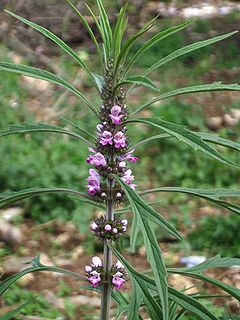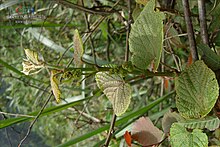
Vitis riparia Michx, with common names riverbank grape or frost grape, is a vine indigenous to North America. As a climbing or trailing vine, it is widely distributed across central and eastern Canada and the central and northeastern parts of the United States, from Quebec to Texas, and eastern Montana to Nova Scotia. There are reports of isolated populations in the northwestern USA, but these are probably naturalized. It is long-lived and capable of reaching into the upper canopy of the tallest trees. It produces dark fruit that are appealing to both birds and people, and has been used extensively in commercial viticulture as grafted rootstock and in hybrid grape breeding programs.

Vitis californica, with common names California wild grape, Northern California grape, and Pacific grape, is a wild grape species widespread across much of California as well as southwestern Oregon.

Leonurus sibiricus, commonly called honeyweed or Siberian motherwort, is an herbaceous plant species native to China, Mongolia, and Siberia. It has verticillaster inflorescence. It is naturalized in many other parts of the world, including South, Central and North Americas.

Vitis (grapevines) is a genus of 79 accepted species of vining plants in the flowering plant family Vitaceae. The genus is made up of species predominantly from the Northern hemisphere. It is economically important as the source of grapes, both for direct consumption of the fruit and for fermentation to produce wine. The study and cultivation of grapevines is called viticulture.

Plumeria obtusa, the Singapore graveyard flower, is a species of the genus Plumeria (Apocynaceae). It is native to the West Indies, southern Mexico, Belize, Guatemala, and Florida. but widely cultivated for its ornamental and fragrant flowers around the world, where suitably warm climate exists. It is reportedly naturalized in China.

Juncus bufonius, known commonly as toad rush, is a widespread flowering plant species complex in the rush family Juncaceae.

Vitis davidii is a species of vining plant native to Asia. The plant grows to a height of up to 8 m (25 ft) and bears small, black grapes. It is also known as the chinese bramble grape.
Vitis mengziensis is a species of plant in the grape family. It is found in the province of Yunnan in China, where it is known by the name meng zi pu tao, meaning Mengzi or Mengtze grape. The specific epithet mengziensis and vernacular Chinese name refer to Mengzi, a county in the southeast of Yunnan. It grows in temperate rainforests, at elevations near 1600 meters.
Vitis hui is a species of plant in the grape family. It is native to Jiangxi and Zhejiang provinces in China, where it is called lu shan pu tao, meaning Mount Lushan grape. It grows in temperate climes, at elevations between 100–200 meters in shrublands and along the edges of open meadows.
Vitis balansana is a species of climbing vine in the grape family native to temperate and tropical Asia. Its native range encompasses Vietnam and three southeastern provinces in China The habitat of V. balansana varies; it has adapted to living under forest cover, and in sun-soaked shrubland valleys, at between 200–800 meters.

Vitis vulpina is a North American species of herbaceous perennial vines in the grape family. It is widespread across most of the eastern and central United States as well as the Canadian Province of Ontario.
Vitis silvestrii is a species of polygamo-dioecious plant in the grape family native to the forested slopes of western Hubei and southern Shaanxi in China from 300 to 1200 meters above sea level. Its flowers appear in May, males having abortive pistils
Vitis bryoniifolia is a prolific and adaptable, polygamo-dioecious species of climbing vine in the grape family native to China, where it is known as ying yu, or hua bei pu tao. The variant form ternata is known as san chu ying yu, meaning three-foliolate, or -leaflet ying yu. Ying yu translates to mean "hard jade".
Vitis heyneana is a species of climbing vine in the grape family endemic to Asia. It can be found in shrubby or forested areas, from almost sea-level, to 3200 meters above. It has globose berries that are purple to almost black.

Pogonia is a genus of orchids belonging to the subfamily Vanilloideae.

Hypericum patulum, known as goldencup St. John's wort or yellow mosqueta, is a species of flowering plant in Hypericumsect. Ascyreia.
Vitis × champinii, or Champin's grape, is a hybrid grape resulting from the natural hybridization of Vitis mustangensis with Vitis rupestris. Its native range is Edwards Plateau in Texas.

Pyrrhopappus pauciflorus, commonly known as smallflower desert-chicory or Texas dandelion, is a species of flowering plant in the family Asteraceae. It is native to the southern United States and northern Mexico. It is a weedy annual found in prairies, clay soils and disturbed habitats.

Osmanthus armatus, also known by the common name devil wood or Chinese vernacular name 红柄木犀 is a species in the genus Osmanthus in the family Oleaceae. It is native to China, specifically the west or central and southeast.

Vitis pseudoreticulata, commonly known as the wild Chinese grape or eastern Chinese grape, is a Chinese liana in the grape family. It is native to eastern China, specifically the provinces of Anhui, Fujian, Guangdong, Guangxi, Henan, Hubei, Hunan, Jiangsu, Jiangxi, and Zhejiang. The plant grows at altitudes of 100–300 m (330–980 ft) and bears medium sized purplish-black grapes. It has been observed to be resistant to damage from moisture, white rot, anthracnose, and Downy mildew.












